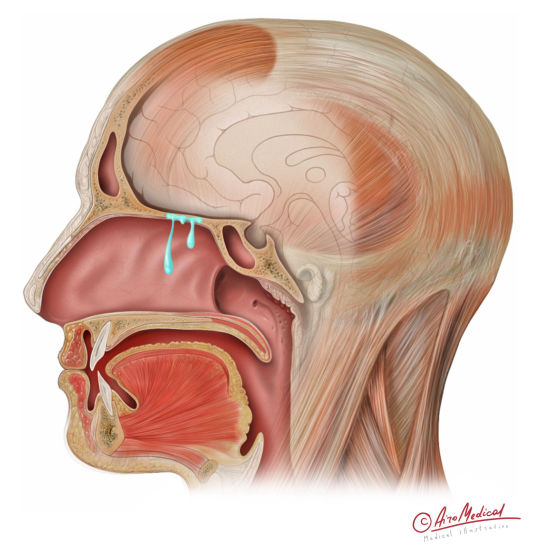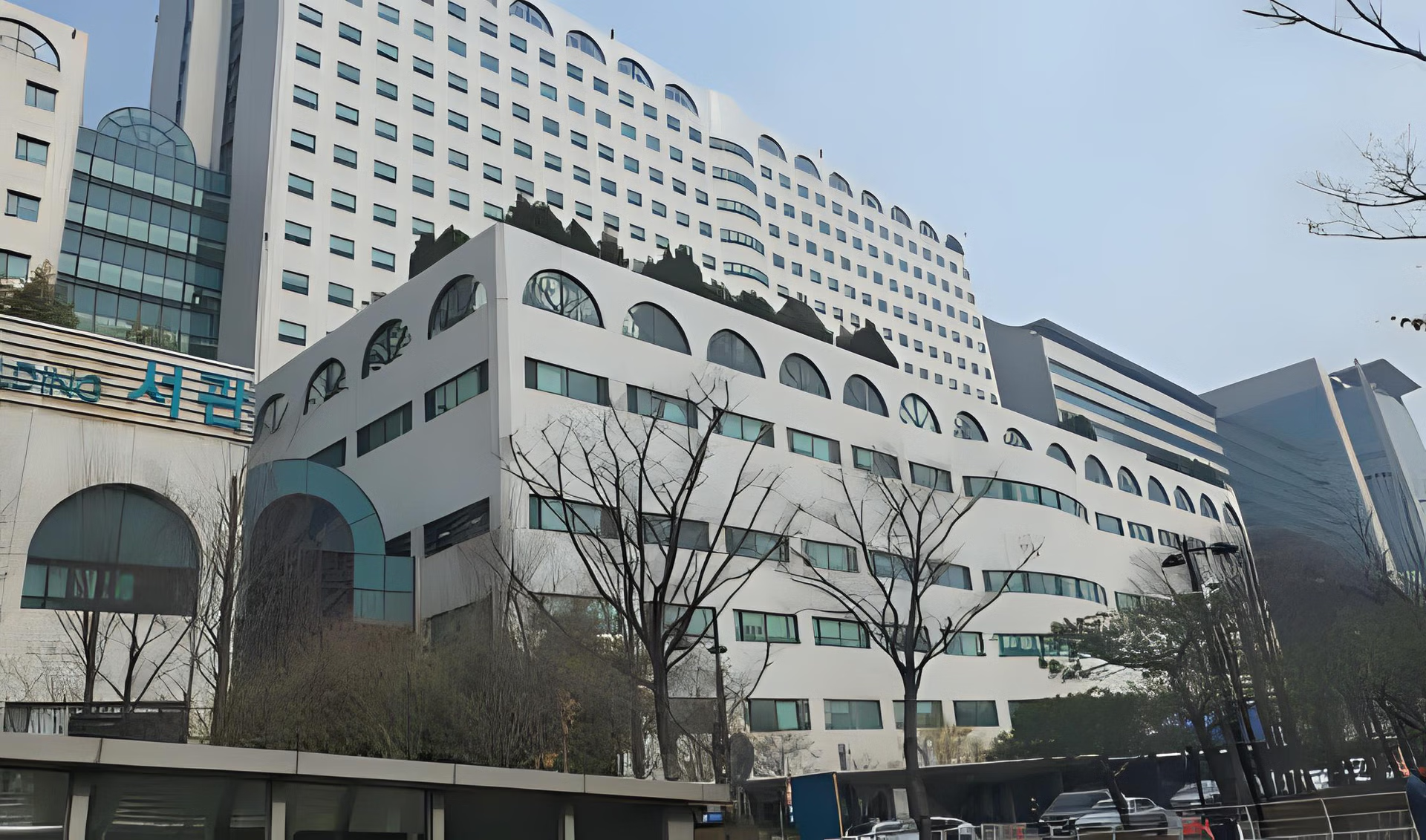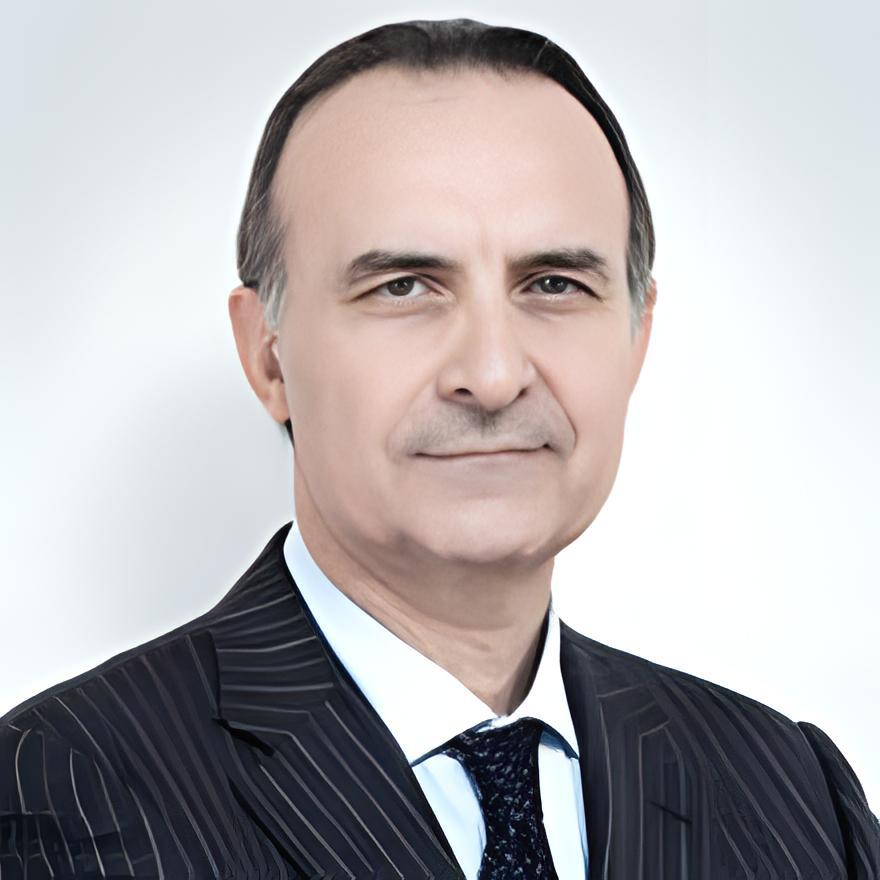Cerebrospinal Fluid Leak Guide

Up to 30% of skull base fractures, 9% of open head injuries, and 3% of closed head injuries end up with cerebrospinal fluid leaks.
About 30-38% of patients with a cerebrospinal fluid leak will have a relapse.
Each third case of cerebrospinal fluid leak leads to meningitis.
The 1-year mortality rate among patients with CSF leaks is 8,5 - 10,9%.
 What is brain fluid?
What is brain fluid?
Cerebrospinal fluid (CSF) is a colorless, transparent fluid produced inside the brain. CSF can be found around and inside the brain and spinal cord. It's an essential part of the nervous system, with many vital functions. Among them are:
- Protection. CSF helps to prevent brain and spinal cord injuries by absorbing energy during mechanical hits.
- Maintaining stable working conditions for the nervous system. CSF helps to maintain a proper level of nutrients and other vital substances in the neurons.
- Removing waste products. With the flow of CSF, the brain and spinal cord get rid of various waste cells functioning products.
On average, around 150 ml of CSF is always presented inside the skull and central canal of the spinal cord. In addition, the brain produces up to 25 ml of CSF an hour and about 500 ml of CSF daily. The brain's ventricles (specific small cavities inside the brain tissues) create CSF. The fluid usually fills all those cavities.
Most components of CSF come from the human blood, but it contains fewer proteins, has a different level of microelements, and is almost free of any cells. The brain liquid goes down from the brain, reaches the bottom of the spinal cord, and is slowly absorbed during this passage.
 What is a CSF leak?
What is a CSF leak?
Unfortunately, in some cases, various reasons might disrupt the flow of CSF. For example, doctors may suspect the cerebrospinal fluid leak when CSF escapes its usual localization site. CSF mostly appears on the body's surface, disturbs patients, and motivates them to seek medical assistance.
 CSF leaking from the ear and nose together makes up to 90% of all cerebrospinal fluid leak cases. Still, in some instances, Brain fluid leak might appear on the surface of the skull or back. Occasionally, those types of lesions might occur in the eye area. However, the primary site of about 80% of all CSF leak cases is located in the brain, and the remaining 20% is related to the spinal cord.
CSF leaking from the ear and nose together makes up to 90% of all cerebrospinal fluid leak cases. Still, in some instances, Brain fluid leak might appear on the surface of the skull or back. Occasionally, those types of lesions might occur in the eye area. However, the primary site of about 80% of all CSF leak cases is located in the brain, and the remaining 20% is related to the spinal cord.
Various medical conditions might lead to a cerebrospinal fluid leak. To simplify the classification and make it easier for the statistical count and next accounting, doctors worldwide decided to separate the range of cases into four main categories of cerebrospinal fluid leaks:
- Traumatic. The group includes all CSF leaks related to any physical damage (fracture, bone cracks, woundings, etc.). It includes up to 80% of all cases of the following disease.
- Iatrogenic (related to actions of medical practitioners). The group includes around 16% of all traumatic CSF leak cases. Each case of this type of leak is always related to various actions of medical practitioners. For example, they could result from surgery, lab test material gathering, and other procedures.
- Congenital. These CSF leaks result from abnormalities in newborns' nerve systems, skull, vertebral column anatomy, and certain neurological diseases.
- Spontaneous. The group includes all cases of CSF leaks that aren't related to any of the previous groups. For example, up to 45% of accidental cerebrospinal fluid leaks occur due to high intracranial pressure.
All cases also divide into immediate (acute) and delayed. For instance, up to 60% of all traumatic brain fluid leaks occur after 3-4 days since the primary trauma and considering acute. But in some cases, the symptoms might occur only after up to 8 months and even longer. In that case, it is considered delayed.
 Cerebrospinal fluid leak risk factors
Cerebrospinal fluid leak risk factors
Sometimes, the probability of CSF leaks increases due to specific factors. Patients might influence some of those factors to decrease the likelihood of the leak symptoms during their life. Still, a vast part of risk factors can't be significantly affected by patients.
Among the most important risk factors
- Age. Patients younger than 65 years have up to 10% more likely to get a cerebrospinal fluid leak.
- Obesity. Patients with obesity have up to 2,8 more chances of getting a cerebral fluid leak compared to those who don't have excess body weight.
- Gender. Women in menopause are more likely to develop leak symptoms due to a low density of bone tissues. But young men are more likely to get a traumatic CSF leak due to a predisposition to risk behavior.
- Certain diseases. Patients with neurosurgical conditions such as pseudo meningocele and hydrocephalus have 18,7 times more likely to develop a cerebrospinal fluid leak.
- Radiation impact. Previous radiation impact on the patients increases the risk of a CSF leak development.
- Certain surgeries and medical procedures. Any previous surgeries or medical procedures related to brain or spinal cord treatment significantly improve the probability of developing a cerebrospinal fluid leak.
Among the most crucial risk factors is also increased intracranial pressure. Still, in most cases, this symptom is related to other conditions, like hydrocephalus. Nevertheless, a detailed medical check-up in a reliable clinic can significantly decrease the probability of a CSF leak occurring after surgery or due to spontaneous factors' impact, including increased intracranial pressure.
Prevention of the condition
Methods of preventing a cerebrospinal fluid leak are strongly related to its primary cause. For example, doctors use tiny intestinal submucosal grafts to avoid a CSF leak after brain surgery. Compared to traditional surgery, this method tends to decrease the probability of further development of leak symptoms by up to 70%.
Still, those methods of CSF leak prevention vary depending on a specific type of procedure or surgery. But here are a few methods of cerebrospinal fluid leak prevention that will help every patient:
- Weight decrease. As patients with obesity have more chance of developing a cerebrospinal fluid leak, regular workouts, eating healthy meals, and other activities that help to decrease body weight are helpful to prevent potential CSF leaks.
- Сompliance with safety rules. Because up to 80% of all patients with a cerebrospinal fluid leak develop it due to trauma, it would be helpful to stick to various safety rules.
- Consuming vitamin D. As vitamin D is one of the most important substances that help to maintain good bone density, it's essential to consume vitamin D-reach food along with health supplements to help prevent the development of cerebrospinal fluid leak.
- Timely treatment of certain diseases. If specific pathologies that lead to cerebrospinal fluid leak development are left untreated for a long time, the probability of CSF leaks will increase. So, it's essential to undergo treatment promptly.
Also, talking with your neurosurgeon or other specialists regarding possible prevention is essential before undergoing any medical procedure that might lead to developing a brain fluid leak.
AiroMedical makes it possible to find the best medical practitioners that might help prevent or treat CSF leaks after medical procedures, traumas, or other reasons with the best possible outcomes.
 Symptoms of cerebrospinal fluid leak
Symptoms of cerebrospinal fluid leak
CSF leaks as an independent state don't show a significant tendency to develop many various symptoms. Still, it's important to remember that it can be mixed with the signs of pathologies that lead to the development of the disease. For example, among the most frequent signs of a cerebrospinal leak are the following:
- Ear, nose, or wound fluid leak. This main symptom naturally creates the name for the whole state. Medical practitioners usually use various lab tests to determine cerebrospinal fluid.
- Headache. It's the second of the most common symptoms of cerebral fluid leak that might accompany the patient until he gets better.
- Salty taste. Up to 40% of patients with a cerebrospinal fluid leak from the nose reported this symptom.
- Ear fulness. Due to the specific anatomy of the inner and middle ear, the cerebrospinal fluid leak might result in filling both of these cavities. As a result, ear fullness occurs.
- Hearing loss. One of the less presented symptoms. It might occur in up to 10% of cerebrospinal fluid leak cases.
Occasionally, a brain fluid leak might show some other signs. However, it's crucial to remember that symptoms of CSF leak are strongly related to the primary pathology. Therefore, always seek medical assistance in reliable clinics and hospitals to prevent further complications.
Also, always essential to seek a distant opinion to detect other possible pathologies that might mimic the cerebrospinal fluid leak and avoid unnecessary treatment.
 Diagnostic tests to determine a cerebrospinal fluid leak
Diagnostic tests to determine a cerebrospinal fluid leak
In most cases, patients with a leak show only symptoms related to the primary disease combined with the leak of a colorless, clear fluid from the ear, nose, or wound. However, in up to 50% of cases, a CSF leak fluid color might vary due to a mix of blood, saliva, or other body fluids.
That creates additional importance to undergo a medical examination and tests to determine the presence of cerebrospinal fluid. The CSF leak test variety includes:
- Lab tests. Those tests are considered a golden standard of cerebrospinal fluid detection. Among them are the Handker chief test, glucose oxidized test, β2 Transferrin test, and glucose and chlorine concentration test.
- Medical imaging. When medical practitioners confirm the CSF leak via lab tests, they also need to find its site. CT, X-ray, and MRI are mainly used to find the leak's location.
- Myelography. During this test, medical practitioners use various contrast dyes to get a clear view of the cerebrospinal fluid leak flow and develop the most suitable treatment plan.
In most cases, doctors verify the diagnosis with various lab tests, especially after traumatic injuries. Then, after they ensure CSF is escaping its usual site, medical practitioners attempt to find the source of the leak. Only after the location of the brain fluid leak is found, physicians start to plan further treatment.
Countries with the most developed treatment
 Traditional treatment options for CSF leaks
Traditional treatment options for CSF leaks
When answering the question: "Is a CSF leak a serious condition?" it's important to showcase that 19% of cerebrospinal fluid leak cases lead to meningitis with an average mortality rate of 10%. As a result, timely treatment of the CSF leak is one of the most crucial tasks for all doctors around the globe.
Among the most popular methods of cerebrospinal fluid leak treatment are:
- Conservative method. Patients receive medications during non-surgical treatment of a cerebrospinal fluid leak and should remain in a stable position with an elevated up to 30 degrees head side of the bed. Constant care and observation by medical practitioners are crucial during this period. This is the most usual and easy treatment for the leak from the nose. Any possible actions involving physical activity or switching positions are strongly prohibited during the treatment. It might take up to ten days, and if doctors don't see results, they will consider other treatment options.
- Surgical repair. If the patient's state allows, surgical repair of the CSF leak considers only after ten days of previous conservative treatment. There are two main classical approaches to the surgical treatment of a cerebrospinal fluid leak:
- Intracranial surgery. During intracranial surgery, neurosurgeons get a clear vision of the cerebrospinal fluid leak site via a hole in the skull. Intracranial surgery success rates range from 50 to 75%.
- Extracranial surgery. During these procedures, surgeons approach the site of the cerebrospinal leak from the orbit, nose, or ear. Extracranial surgery shows 86% efficiency. Still, it tends to fail to detect any other possible issues and lesions (e.g., brain metastases, meningocele, etc.) compared to intracranial CSF leak surgery.
- Lumbar drain. Medical practitioners often insert a sterile tube in the lower (lumbar) part of the patient's back to decrease the intracranial pressure and make it easier for a leak to heal. As a result, excessive CSF will be removed from the body. Lumbar drain often combines with a conservative treatment approach.
Due to the specific nature of the condition, treatment is strongly related to the leading cause of the pathology. Also, the possible method of surgery for a CSF leak might vary depending on the site of the leak, and many neurosurgeons might use slightly different approaches, surgical technics, and materials to repair the leak.
And at last, it's essential to prevent possible complications of a cerebrospinal fluid leak by prescribing antibiotics and other necessary medications. For example, if, for some reason, a patient needs to decrease intracranial pressure but they can’t undergo lumbar drain due to certain contraindications, doctors might prescribe diuretics to reduce it.
Verified CSF leak centers
 New treatment for a cerebrospinal fluid leak
New treatment for a cerebrospinal fluid leak
Unfortunately, up to 38% of patients who got surgical treatment due to a cerebrospinal fluid leak got a relapse 10-77 months after the primary therapy. As a result, doctors keep working on finding new treatment methods for CSF leaks that can be used as an alternative to traditional approaches.
Among the most recent and most practical findings are the following:
- Epidural blood patch (EBP). During this treatment, a small portion of the patient's blood is injected into the epidural space to stop fluid leaking. 71,4% of patients require only a single patch to eliminate symptoms. This method of CSF leak repair is mostly used to stop spinal cerebrospinal fluid leaks.
- Trans-venous embolization. A flexible, thin tube inserts into the big vein and reaches the closest vein near the cerebrospinal fluid leak site. After that, a small portion of the substance that helps to close the leak is inserted via a tube.
- Absorbable collagen sponges. This treatment method involves the placement of a small sponge on the site of a potential brain and spinal fluid leak. It is mainly used after a small-sized spinal cord and brain tumor removal.
- Sealant. Sometimes doctors use a special non-toxic glue to close a cerebrospinal fluid leak. In addition, these substances often mix with the patient's blood to achieve the best results.
- Endoscopic transnasal surgery. During this treatment, surgeons reach the site of the cerebrospinal fluid leak via the nose and use exclusively endoscopic instruments. This method is traditionally associated with a low frequency of side effects and relapses. As a result, up to 90% of CSF cases are successfully cured after the first treatment session.
- Hydroxyapatite cement (HAC). Hydroxyapatite cement is a powder that can successfully help in various bone repair procedures. Doctors began using it not so long ago to treat CSF leaks in patients with skull bone fractures.
- Surgery with the use of multilayer technic. When the surgery with multilayer technic performed, neurosurgeons use two or three layers of different materials to repair a cerebrospinal fluid leak. The multilayer technic is especially effective for damage over 2 cm in diameter.
It's also important to remember that various doctors and scientists are developing methods of alternative treatment for CSF leaks that only undergo various clinical trials and will be available for most patients in the future.
Therefore, AiroMedical will gladly help patients with severe or recurrent cases of cerebrospinal fluid leak to become a part of clinical trials and get a chance for a successful treatment.
Best doctors who treat CSF leak
 Statistics and prognosis for patients with a cerebrospinal fluid leak
Statistics and prognosis for patients with a cerebrospinal fluid leak
The prognosis for patients with a cerebrospinal fluid leak is primarily convenient. Still, a significant chance of complications, including meningitis and relapses, is presented in case of bad, wrong, or no treatment.
Unfortunately, surgical treatment of CSF leak is also often associated with various side effects and complications. Therefore, it's always important to stick to conservative treatment first, and only if it's not showing satisfactory results undergo surgical treatment.
Nowadays, doctors traditionally consider spontaneous CSF leak relapses as one of the most dangerous complications that require immediate treatment. Still, up to 30% of patients with a verified cerebrospinal fluid leak will eventually have a relapse during their lifetime, regardless of the chosen treatment method.
So, it's essential to clearly understand the treatment's potential success rate that will help achieve good results after the first sessions. Take a look at that data chart:
Cerebrospinal fluid leak treatment's success rate after the first session
- Endoscopic endonasal surgery - 90%
- Extracranial surgery - 86%
- Intracranial surgery - 75%
- Epidural blood patch - 71,4%
- Conservative treatment - 55%
As you can see, surgical treatment is among the most effective methods, with the most significant success rates after the first treatment sessions. But unfortunately, only some patients are applicable for surgical treatment, and doctors must consider many parameters to decide how to repair CSF leaks most effectively and safely. That is the main reason conservative treatment is one of the first steps in managing any cerebrospinal fluid leak.
Every patient with a brain fluid leak is applicable for conventional treatment, and there are no severe complications and contraindications. This method can also give medical practitioners more time to choose the best treatment method.
It's always helpful to involve in the discussion about treatment options for a cerebrospinal fluid leak as many highly experienced specialists as possible. Therefore, AiroMedical gathered the database of the greatest medical practitioners all around the globe that can help you to treat a cerebrospinal fluid leak most suitably and effectively. And AiroMedical will gladly help you to get a valuable second opinion, as well as to get a treatment plan in the leading hospitals all around the world.
References:
- Galli J, Morelli F, Rigante M, Paludetti G. Management of cerebrospinal fluid leak: the importance of multidisciplinary approach. Acta Otorhinolaryngol Ital. 2021;41(Suppl. 1):S18-S29. doi:10.14639/0392-100X-suppl.1-41-2021-02
- Tai YC, Tai YS, Ou CH, et al. Treatment, Outcome, and Relapse of Spontaneous and Nonspontaneous Cerebrospinal Fluid Leak. Brain Sci. 2022;12(3):340. Published 2022 Mar 2. doi:10.3390/brainsci12030340
- Totten DJ, Manzoor NF, Yancey KL, Yawn RJ, Haynes DS, Rivas A. Comparison of Small Intestinal Submucosal Graft and Autologous Tissue in Prevention of CSF leak after Posterior Fossa Craniotomy. J Neurol Surg B Skull Base. 2021;82(6):695-699. Published 2021 Mar 12. doi:10.1055/s-0040-1713772
- Oh JW, Kim SH, Whang K. Traumatic Cerebrospinal Fluid Leak: Diagnosis and Management. Korean J Neurotrauma. 2017;13(2):63-67. doi:10.13004/kjnt.2017.13.2.63
- Schievink WI, Maya MM, Riedinger M. Recurrent spontaneous spinal cerebrospinal fluid leaks and intracranial hypotension: a prospective study. J Neurosurg. 2003;99(5):840-842. doi:10.3171/jns.2003.99.5.0840

















